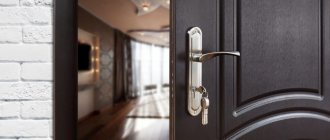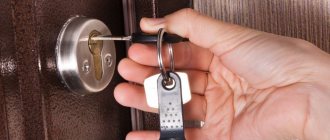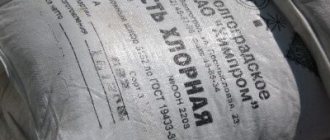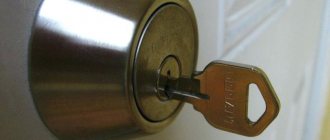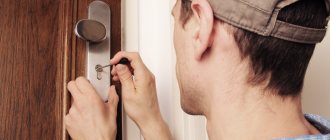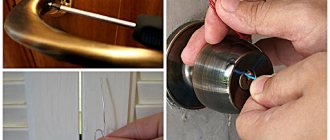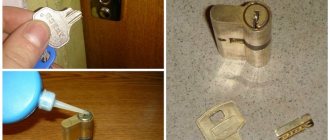Almost every person locks the door when leaving home. Therefore, sooner or later you encounter a problem when the front door lock for some reason has become unusable. This is quite natural, because every item deteriorates and breaks over time, which means the time comes to repair the lock or completely replace it. Usually it is enough to replace the lock core and the door will be locked again. How to remove the lock cylinder of the front door and replace it without calling a technician, read our article.
Bumping
Non-destructive method for breaking profile cylinders.
The method is based on impact on the cylinder pins with parallel application of force to the mechanism in the direction of unlocking the lock. This method uses a specially manufactured key blank for a specific profile cylinder. As a measure to counteract bumping, there are several constructive solutions:
- use of other elements in the cylinder design (for example, disks, frame cylinders)
- combination of cylinder mechanisms with other security elements (frames + pins)
- additional recognition elements in the cylinder mechanism and key (for example, a wheel)
- protective pads blocking access to the end part of the cylinder mechanism, magnetic and code pads
How to remove the cylinder from a lock without a key
You can remove the lock cylinder of the front door without using a key. The following methods are used for this purpose:
- knocking out;
- breaking out;
- drilling;
- bumper key;
- call a specialist.
You can remove the lock cylinder both with the front door open and closed. Various methods are used for this.
Knocking out the secret
This is a radical method of how to get the larva. It is used only when it is urgent to open the door and get into the apartment. You will also have to knock out the larva if other methods have not helped. You must understand that after knocking it out, you will need to completely change the entire lock. It won't be possible to fix it. You can knock out the larva using improvised means. Many people wonder whether it is possible to knock out a lock cylinder with a hammer. This is the tool best suited for the job. A chisel is also used. With their help they break the secrecy mechanism. The metal is deformed and then the larva is released. Next, you just need to click on the bolt and access to the room will be open.
It is better to use a large hammer for knocking out. A lightweight tool is unlikely to cope with the task. The chisel needs to be taken with a slightly smaller diameter than the larva. Otherwise, the door leaf will be severely damaged. Then you will have to change not only the cylinder lock, but the door structure too.
Breaking out
This is an almost ideal way to remove the cylinder from the front door lock without dire consequences for the door leaf and frame. But the cylinder mechanism will be damaged and a new one will have to be installed. The essence of the method is to fix the secret and then turn it sharply. An adjustable wrench is used for this purpose. Another similar tool will do. After breaking out, the secret is completely freed from all fastenings and exits the system. This makes it possible to open the door.
Reaming
Drilling is also a fairly effective way to open an iron door without using a key. But after implementing this method, the larva will have to be replaced. After all, it will be destroyed. The method is not labor-intensive and energy-intensive. Requires the use of a metal drill. The keyhole is drilled to the middle in depth. This allows the pin to be released. It rotates inside the secret. It happens that during drilling the metal bends. Then it is pushed into the larva using a knitting needle. It must be strong, steel.
Bumper key or master key
Using a master key is considered the most optimal option for unlocking the cylinder mechanism without using a key. As a result of its use, all parts of the locking device remain intact. Therefore, there will be no need to replace the system. The exception is situations when the secret is not working. But most often this method is used when the door has slammed and there are no keys to open it.
But we must take into account that to open the door leaf with a master key you need to get used to it. You need to understand the internal mechanism of the key. This will take time. Therefore, you should not hope that you will be able to open the lock the first time.
Special pins – pins – are responsible for secrecy in cylinder devices. They are located on springs. Consist of two parts. If the outer tip of the pin does not fit into the groove of the key, then it will not be possible to turn it. After all, it will not be possible to make a pin center that would interfere with the movement of the core. The more reliable the lock, the higher its security level, the more pins it will have. This means that the likelihood of opening the locking mechanism will be lower.
You can use two wires and pins as a master key. One product should be straight, and the second with a curved end. The latter will be used for tapping pins. It is important to line up the pins correctly. Then it will be easy to open the lock.
Calling a specialist from the emergency service
Knocking out, drilling, and using a master key allow you to open the locking mechanism yourself. But in most cases, after such attempts, other problems appear. For example, you have to think about replacing the door leaf or lock. Therefore, it is better to call a specialist. A professional has the necessary skills, experience, and tools. Therefore, he can simply, quickly and without negative consequences open the lock of the front door, change the secret, the core of the cylinder mechanism if necessary. It will also give useful recommendations on how to avoid similar situations in the future. But you need to understand that the work of a master costs money.
With the door closed
The algorithm for removing the cylinder depends on whether the door block leaf is in a closed or open position. If the door accidentally slams, but there is a key, there should be no problems. The key is inserted into the hole and turned. The work is then carried out with the door open.
With the door closed and without a key, it will not be possible to remove the cylinder. You'll have to break the lock. To do this, use a drill. All pins are drilled out. The drill must be aimed at the protruding part of the cylinder lock. Its thickness is usually 10 mm. Therefore, it is recommended to use a drill with a diameter of more than 6 mm. It is important to ensure that it does not move during operation. After all, not particularly hard metal is used to make the larvae. As soon as the drill reaches the pins, the tool is removed. The larva is simply removed. The broken mechanism is replaced with a new, working one.
Also, if the door is closed, you can try to open it with two pins. Next, the larva is replaced. To do this, unscrew the screws at the end of the door. Then a key or master key is inserted into the keyhole and turned a little. After the drive enters the core of the lock, the secret can be easily removed.
In an open door
If the cylinder needs to be replaced and the sash is open, then no special difficulties should arise. You must act in this order:
- Remove the handle and trim from the door leaf.
- Open the door. At the end of the door, find a fastener in the form of a screw. It holds the face of the cylinder mechanism.
- Insert the key into the keyhole and turn slightly. The actuator that operates the deadbolt must be fully seated in the core body.
- Remove the cylinder mechanism.
After such actions, you can install a new door lock cylinder. Assembly is carried out in reverse order. After replacing the cylinder, you must try to close and open the door with the key several times.
Pick-gun
Pick-gun hacking is the use of a special tool to install pins in a line and rotate the cylinder.
To counter the pick-gun, there are several constructive solutions:
- use of other elements in the cylinder design (for example, disks, frame cylinders)
- combination of cylinder mechanisms with other security elements (frames + pins)
- additional recognition elements in the cylinder mechanism and key (for example, a wheel)
- protective pads blocking access to the end part of the cylinder mechanism, magnetic and code pads
Drilling out the housing
In this method, a channel is drilled in the end part of the cylinder mechanism housing, through which the remains of the pins and return springs are then removed. Next, the mechanism cylinder is simply rotated with a screwdriver or any wrench with the appropriate cross-section profile.
To complicate the use of this method:
- protective linings are used (armored lining, magnetic and coded linings)
- the use of protective inserts made of heat-resistant metal in the design of the mechanism, making it difficult to drill out the functional elements of the mechanism
Main types of locks on entrance doors
Barn padlocks with lugs are a thing of the past. Today on sale you can find 3 basic types of locking mechanisms, each of which has design and functioning features:
- Cylinder - a standard locking device consisting of a steel bolt and core, into which a cylinder cylinder with a unique arrangement of pins for the key is integrated. When the cylinder is turned, the eccentric ring acts on the tongue located in the body of the box, and the door opens.
- Level - has a more complex design - the locking mechanism consists of many stacked plates - level, each of which has its own groove shape. The keys are equipped with a flat bit with similar mirror grooves. It is more difficult to counterfeit such elements, and it is almost impossible to pick the lock, especially when we are talking about high-quality mechanisms from world-famous brands.
Level castle
- Crossbar - easy to install and operate. The principle of operation is similar to a cylinder product, with the only difference being that turning the cylinder does not activate the tongue, but the locking bolts, which go into the holes on the side of the threshold and the door lintel.
Deadbolt lock
Regardless of the design features, as well as the reliability class of the mechanism, a professional can open almost every lock with minimal damage to the door structure.
Manipulation
Using a master key, the pins are installed and the cylinder is rotated with a special tool.
To complicate the use of this method:
- elements of the cylinder mechanism are manufactured with high precision
- to create interference during manipulation, a complex key channel profile is used
- the design of the mechanism uses pins of a certain shape, which complicate the breaking of the mechanism (“mushroom-shaped” or “reel” pins)
- mechanisms with several separate independent pin rows are used
- mechanisms are used with a combination of different types of mechanism security elements (frames and pins)
- mechanisms with “telescopic” pins are used
- protective pads are used that block access to the end part of the mechanism (magnetic and code pads)
Reasons for replacement
It is necessary to replace the locking mechanism cylinder if:
- The lock is worn out and it becomes difficult to unlock. The shelf life of cores from Turkish or Chinese manufacturers is 3-5 years, from European ones – up to 10 years.
- The mechanism is broken or damaged - for example, due to burglary attempts or careless use of the key.
- The lock on the premises was opened.
- The locking mechanism jams, and the key has to be “swinged” when inserted.
- Keys were lost or stolen or were used by strangers.
- The owners and tenants of the premises have changed.
- It was decided to change the lock to a more reliable model.
Attention! It is recommended to replace the cylinder at the first sign of a malfunction. Even small errors in operation can cause the door to lock. In this case, it is often necessary to take drastic measures - especially if children or incapacitated citizens remain locked in the premises.
Trace method
The key blank is rotated all the way, adjustments are made according to the marks on it, and so on until the key fits.
To complicate the use of this method:
- protective pads are used that block access to the end part of the mechanism (magnetic and code pads)
- mechanisms with a perforated key are used
- mechanisms are used with a combination of different types of mechanism security elements (frames and pins)
- mechanisms with “telescopic” pins are used
Seven tips for choosing a new larva
Tip #1. Deciding on the package
According to the configuration, cylinder cylinders come in 2 types:
- Key plus key - an option where keys are inserted on both sides, the good thing is that if you insert the key from the inside, you can’t open the lock from the outside;
- Key plus a screw - if a screw is installed on the inside instead of a key, then in the event of a fire or some other emergency, it will not be difficult to quickly unlock the lock.
The configuration and type of lock cylinder is determined depending on the specific situation
Tip #2. Selecting the privacy level
Pins are responsible for encoding the larvae; they are also called pins; they are located at the bottom of the mechanism. The pins, by means of springs, fit into the cutouts on the key, each pin corresponds to a given position, thus setting the level of secrecy.
- In budget models, 5 pins are installed and secrecy is limited to ten thousand options;
- In the middle price category, 6 pins are installed and the number of options increases to fifty thousand;
- Expensive locks have 6 or more pins, plus additional secrets, such as magnetic inserts. The number of options here starts from one hundred thousand, but usually manufacturers indicate several million.
The more pins are installed on the lock cylinder, the higher the level of secrecy of the mechanism
Tip #3. Lock cylinder weight
If the larva weighs around 100 grams, then you are dealing with a cheap model, the insides of which are made of aluminum or silumin. It won't last long. A high-quality product with a steel or bronze mechanism cannot weigh less than 180 grams, and the weight of some models reaches 250 grams.
You can determine the quality of the larva by weight; the weight of a normal model starts from 180 g
Tip #4. Drill protection
It is impossible to visually see the protection against drilling of the lock cylinder. The fact is that such protection is provided by the internal insert and pins made of high-strength steel. The only advice that can be given in this case is to carefully study the accompanying documentation and choose a reliable manufacturer.
Protection against drilling is provided by steel inserts in the lock cylinder
There are cylinders with vertical milling into which the key is inserted horizontally. Advertising claims that this is a sign of high security, but in reality their resistance to hacking is no different from traditional larvae with a vertical key arrangement.
Larvae with a horizontal keyhole have the same resistance to burglary as their relatives with a vertical key.
Tip #5. Bump protection
Bumping is the name given to knocking out a keyhole with a heavy tool. The robbers place some kind of superstructure on the keyhole and hit it with a heavy hammer or sledgehammer, after which the larva flies inside the home, and without it you can open the lock with any screwdriver.
Anti-bumping cylinders can be recognized by the presence of a special steel bracket on the side of the mechanism. According to the manufacturers, this bracket can withstand heavy loads and will not allow the lock to be knocked out.
The steel bracket serves to protect against knocking out the cylinder with a heavy tool
Tip #6. Magnetic protection
It is not possible to open a cylinder with magnetic protection using ordinary master keys. The fact is that one of the pins of such a cylinder is magnetized and it reacts to a reciprocal magnetic insert that is built into the key, and the insert and pin have their own potential and the first magnet you come across cannot open such a lock.
Larvae with magnetic inserts are found in the middle and upper price categories
Tip #7. Product cost
Determining the quality of a product by its cost is a risky business; a high price may be the result of transportation costs or the banal greed of a businessman, but it is still worth paying attention to this point.
- Now the price for a normal larva starts from 500 rubles. If you are offered an item with fabulous protection at a bargain price, then it is either a fake or a stolen item;
- Larvae with a price ranging from 500 to 1000 rubles are of quite decent quality, in this case it is the average price category;
- Anything that is more expensive than a thousand rubles is already closer to an elite product; often the quality of such products is really high.
Svyortysh
A strong blank is used to mechanically roll up the cylinder, destroying the secrecy of the mechanism.
To complicate the use of this method:
- protective pads are used that block access to the end part of the mechanism (magnetic and code pads)
- do not install profile cylinders of poor quality and low cost
- mechanisms with stronger steel pins are used in the design
- mechanisms with a complex key channel profile are used
Emergency call
Any of the listed methods can be applied either independently or with the assistance of specialists. In this case, the required method will be selected depending on the time during which the door must be opened.
If the lock definitely needs to be left undamaged, then there are organizations that will undertake to open any lock for a reasonable fee. But it’s advisable to find their contacts in advance, so that when something is wrong with the door, you don’t have to run around your neighbors asking to see their addresses and phone numbers.
Chemical hack
The return springs of the pins are dissolved using a liquid poured into the mechanism. After this, the cylinder is turned using a screwdriver.
To complicate the use of this method:
- protective pads are used that block access to the end part of the mechanism (magnetic and code pads)
- mechanisms are used in which the total length of the body pin and the core pin is greater than the length of the code channel to the parting line
- mechanisms with pins in the upper part of the body are used
- mechanisms are used with a combination of different types of mechanism security elements (frames and pins)
How to avoid door problems
To prevent this from happening, it is worth taking periodic preventive measures:
- Lubricate the part with special oil several times a year;
- To make the mechanism last longer, you should not slam doors;
- Outdoor external locks should be regularly cleaned of debris, dust and dirt that fall inside from wind and rain.
If you were unable to open the door yourself, there is no need to break it. Call customer service and they will help you quickly.
